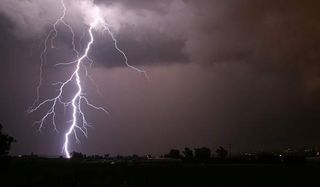
Electrifying News: Lightning Deaths Decline

Floods and tornadoes kill more people in the United States than lightning does, a study finds.
In fact, lightning strikes have been the third-leading cause of storm-related deaths since 2006 and may soon drop to fourth place, below hurricanes, said study author William Roeder, a meteorologist in Rockledge, Fla. Only 28 lightning deaths have been reported so far in 2012.
Lightning accounted for 20.1 percent of storm deaths between 1982 and 2011, Roeder found, while hurricanes took another 17.5 percent. Tornadoes were responsible for 27.6 percent of fatalities, and floods killed 34.7 percent of people who died during storms.
The downward trend in lightning deaths began in 1940, with the urbanization of the United States, Roeder told OurAmazingPlanet. About 300 people died from lightning every year before the '40s, most of them working on farms or outdoors. Now, with changes in work patterns and the advent of national safety campaigns, Roeder's study predicts 31.7 deaths this year.
The drop to third place has gone unnoticed because of the way official statistics are tracked, Roeder said. The National Oceanic and Atmospheric Administration keeps a 30-year running average, which predicts 54 people should die by lightning strikes this year. But safety campaigns kicked off in 2001 sharply dropped the number of lightning deaths each year, so that 30-year average consistently overestimates fatalities because it includes data from before the recent decline, Roeder said. "Running averages only work if you assume your data is isn't changing over time, which is good for floods, but not lightning," he said. Even a 10-year estimate doesn't completely eliminate the problem, because one extreme year will skew the result, Roeder said.

Roeder's work revises predictions of lightning deaths by fitting a statistical curve to the historic data instead of averaging over time. "That gives me the value expected for this year and in the future, and I can also put some error bars on it and answer questions like, 'Was 2011 a record low year for lightning deaths?'" Roeder said. There were 26 reported fatalities in 2011. "That was just inside the error bars of what my curve said it should have been. It was low, but it wasn't statistically significant," he said. Roeder is a lighting safety advocate who conceived national slogans including "Don't be fried, go inside," and "When thunder roars, go indoors."
"Those of us in the lightning safety community like to joke that we're putting ourselves out of business, and that's a good thing," he said.
Sign up for the Live Science daily newsletter now
Get the world’s most fascinating discoveries delivered straight to your inbox.
Roeder said he would like to see even fewer lightning deaths, to "find a brand new way to bend that curve even lower."
"Lightning kills only about 10 percent of people it strikes. About 90 percent survive, but many suffer life-long debilitating injuries," Roeder said. Since 1995, more than 80 percent of victims have been men, according to NOAA statistics.
"Lightning is more frequent and a bigger threat than most people usually know."
The research was detailed at the National Weather Association's annual meeting in October.
Reach Becky Oskin at boskin@techmedianetwork.com. Follow her on Twitter @beckyoskin. Follow OurAmazingPlanet on Twitter @OAPlanet. We're also on Facebook and Google+.

Most Popular

